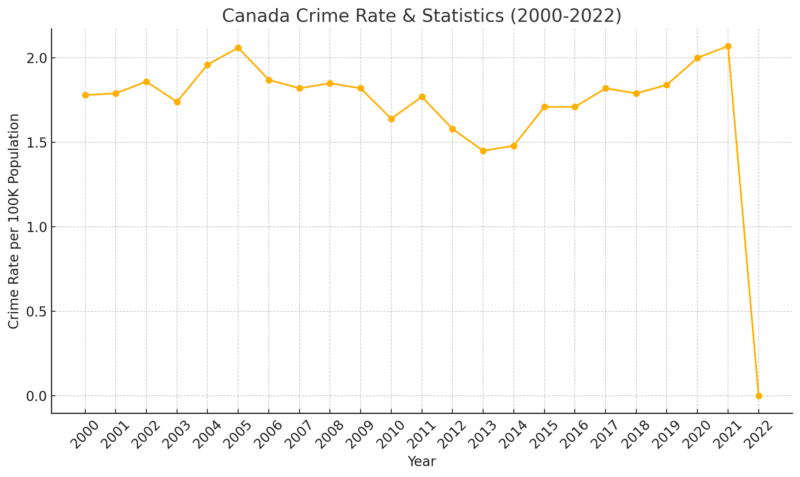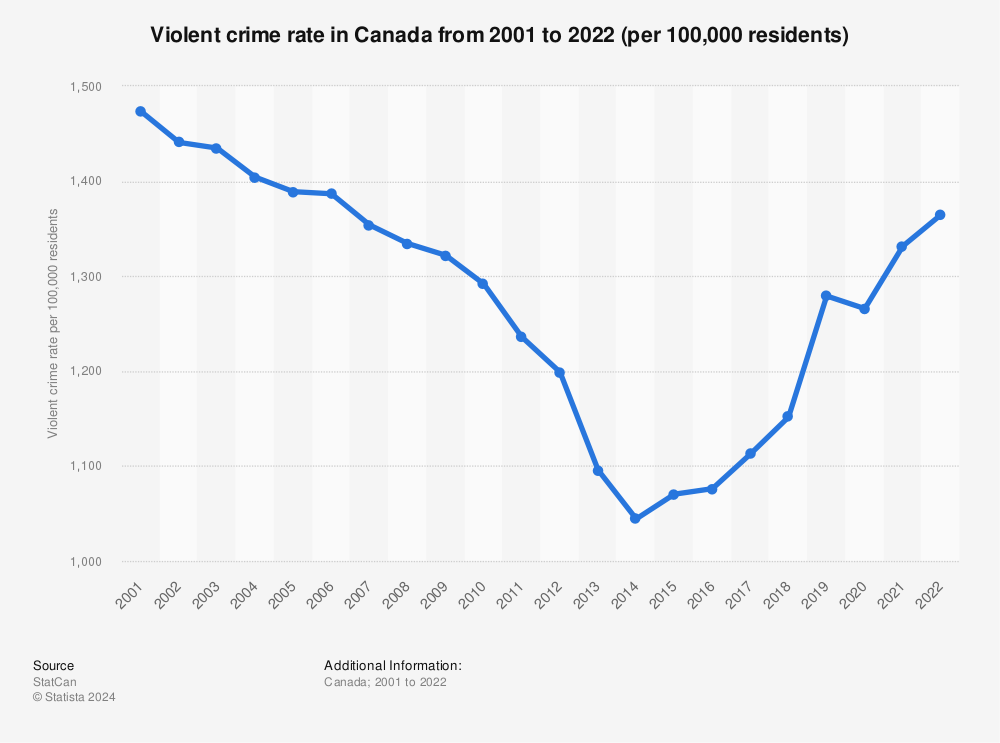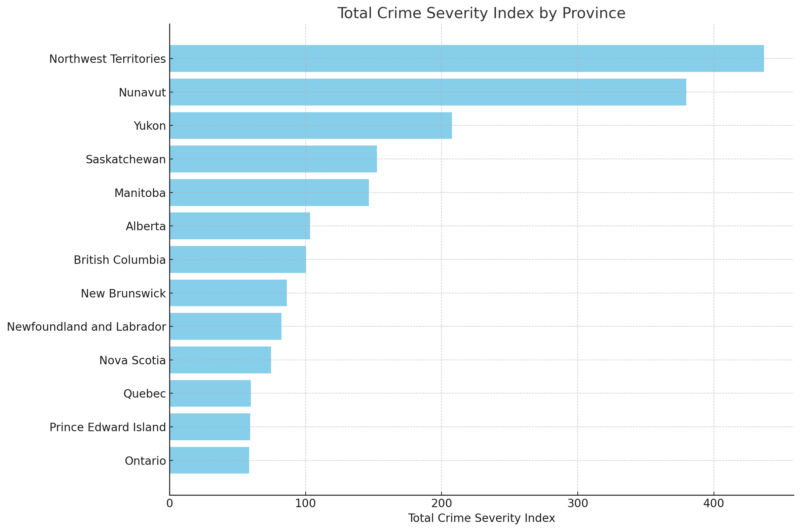The crime rates in Canada have seen fluctuations over recent years, with distinct differences between urban and rural areas.
In urban areas, crime rates decreased by 11% between 2019 and 2020 and have remained stable since then.
Conversely, rural areas experienced a 2% increase in reported incidents in 2021, following a slight drop in 2020.
Interestingly, the rate of violent crime showed a significant rise in rural regions, being 7% higher in 2021 compared to 2019.
Insights into the crime statistics reveal that while there has been an uptick in violent crime, the rates remain considerably lower compared to the peak levels observed in the 1990s.
Table of Contents
ToggleCanada Crime Rates In 2000-2025

Canada has seen a significant fluctuation in crime rates over the decades. In the early 2000s, crime peaked, with 2003 marking a high point. Since then, a general decline has been observed according to Statistique Canada.
However, recent years have shown variation in trends.
For example, Canada experienced a 3.1% increase in the crime rate in 2021 compared to 2020 as per Macrotrends.
These changes reflect various factors, including social dynamics, economic conditions, and law enforcement practices.
Urban and rural areas have different patterns, with urban crime rates generally decreasing, while rural areas have seen slight increases in specific crime categories.
Overall, according to the Institute for Economics & Peace and World Population Review, Canada is ranked the 11th safest country in the world out of 163 countries.
National Crime Statistics
In 2025, Canada’s crime rate continues to reflect these broader historical trends. The Crime Severity Index (CSI) increased by 4% in 2022, indicating a rise in police-reported crimes in various cities. Violent crime rates are particularly noteworthy, with the Violent CSI reaching its highest point since 2007.
Property crimes have generally declined, showing a significant drop from peak levels in the early 2000s. These figures offer a nuanced picture of crime, suggesting ongoing shifts in different types of criminal activity with the highest crime rate in Canada.
Regional Analysis
Urban areas have generally reported a decrease in crime, with rates dropping by 11% between 2019 and 2020 and remaining stable into 2021.
Conversely, rural regions have shown an increase in certain types of crime.
Violent crime in rural areas rose by 3% in 2021 compared to the previous year and was 7% higher than in 2019 and it was the highest crime rate in Canada ever reported. These discrepancies highlight the importance of regional context when assessing the highest crime rate in Canada.
Types of Crimes Reported
Violent Crimes
Violent crimes in Canada encompass offenses like assault, robbery, and homicide. Recent data indicates a slight increase in the rate of violent crime, with 2.08 incidents per 100,000 population in 2022.
Although this represents a rise, it’s still significantly lower than the historic highs of the 1990s.
Notably, the rate of robbery increased by 15% in 2022, though it remained 10% lower than in 2019. These statistics highlight the need for ongoing vigilance and targeted strategies to address violent crime.
According to Statista, Canada reported a rate of 2.25 homicides per 100,000 population, compared to the US rate hovering around 6.3 per 100,000.
Property Crimes
Property crimes, including theft, burglary, and vandalism, remain a significant concern.
Statistics Canada reports a rate of 3,314.2 incidents per 100,000 population in 2022.
The overall rate and trends of property crimes have fluctuated. For example, while Canada’s urban areas saw a decrease in crime rates between 2019 and 2020, rural areas experienced different trends.
Property crime trends provide essential insights for law enforcement and community safety initiatives, aiding in the development of preventive measures. And as of 2023 rate dropped by 11 % says the Vancouver Police Department.
Cybercrimes
These crimes often involve fraud, identity theft, and online harassment, with perpetrators exploiting digital platforms to target victims.
The rise in cybercrimes is a critical area for both law enforcement and the public to address.
Although Reuters says that Canada doesn’t have tools to fight cybercrime.
Drug-Related Offenses
In Canada, the landscape of drug offenses has seen shifts and trends over the years, captured in a recent report titled “Profile and Projection of Drug Offences”. Looking into the data from 1977 to 1998, the report highlights a decrease in the number of adults charged with drug offenses during that period. Noteworthy changes include a decrease in cannabis-related charges and an increase in cocaine offenses in the 1980s.
Drug possession emerged as the most prevalent offense, accounting for 55% of all adult drug charges. However, the proportions of different drug offenses have shown stability in recent years. The report projects a modest 6% increase in the number of adults charged with drug offenses over the next five years, with varying trends across different jurisdictions in Canada.
Highest Crime Rate in Canada by Province
Crime Prevention and Community Safety
Public Awareness Initiatives
Public awareness initiatives play a crucial role in crime prevention. These campaigns educate citizens on how to detect and report suspicious activities. They often include informational sessions, brochures, online resources, and social media outreach.
For example, the National Crime Prevention Strategy provides tools and resources for communities to implement localized safety programs. Emphasizing community involvement, these initiatives foster a shared sense of responsibility. Such efforts aim to reduce incidents of various crimes, including theft and domestic violence, by empowering people to take preventive measures in their daily lives.
Community Policing Efforts
Community policing is integral to maintaining public safety. This approach focuses on building relationships between law enforcement and community members. Officers are encouraged to engage with residents, understand their concerns, and work collaboratively to address local issues.
Youth Programs and Education
Youth programs and education are pivotal in preventing crime. Targeted initiatives such as after-school activities and educational workshops aim to engage young individuals constructively. These programs provide youths with skills, mentorship, and opportunities, steering them away from criminal activities.
Programs funded by Public Safety Canada focus on at-risk youth, offering support through mentorship and community involvement. Educational initiatives often address issues like bullying, substance abuse, and internet safety. Engaging youths early helps to reduce the likelihood of them engaging in criminal behavior, contributing to long-term community safety.
Criminal Justice System
The court system serves as the forum where criminal cases are tried and guilt or innocence is determined. Trial procedures can involve several stages, including arraignment, pretrial motions, trial, and sentencing.
Canada’s court system strives to be fair and transparent. According to the 2023 National Report, just under half of the respondents expressed confidence in the youth criminal justice system. The performance metrics of the courts are periodically reviewed to ensure efficiency and accuracy.
Conviction rates are critical indicators of the performance of the justice system. Reliable conviction data not only help assess the effectiveness of the courts but also provide insights into crime trends and judicial practices.
Rehabilitation and Corrections
Rehabilitation aims at reintegrating offenders into society as law-abiding citizens. Correctional facilities offer various programs, including vocational training, education, and therapeutic services, to address the root causes of criminal behavior.
Canada’s correctional system emphasizes the importance of rehabilitation. Despite variations in public awareness, efforts continue to ensure that correctional services are impactful and accessible.
Data from the State of the Criminal Justice System Annual Report showed that awareness of corrections remains low, with only 26% of Canadians aware of the correctional role in 2021, down from 32% in 2018.
Victim Support Services
Victims of crime in Canada can access a variety of resources aimed at providing immediate and long-term assistance. The Federal Victims Strategy (FVS) aims to increase access to justice and services for victims and survivors, supporting a coordinated approach across the country.
Organizations like the Office of the Federal Ombudsperson for Victims of Crime provide crucial information and support through their recommendations and reports.
Additionally, initiatives such as Victim Crisis Assistance Ontario address immediate needs through specially designed services for different victim demographics. This includes anti-human trafficking programs and support for senior victims of crime.
The Victims and Survivors of Crime Week provides educational efforts and raises awareness by highlighting facts and statistics that communicate the impact and needs of victims.
Advocacy and Legal Support
Advocacy and legal support form a critical aspect of victim support services. The recommendation for a national Crime Victims’ Support Service emphasizes the importance of providing consistent, reliable information about victims’ rights. This proposed service would include a national, toll-free, 24/7 helpline, akin to existing services in Europe.
Family Court Support Workers (FCSW) and other specific legal support initiatives also play a role in assisting people from Canada who are victims. These services guide victims through court processes, ensuring they are informed and prepared. Efforts to support victims are multi-faceted, aiming to provide both practical assistance and emotional support throughout legal proceedings.


















